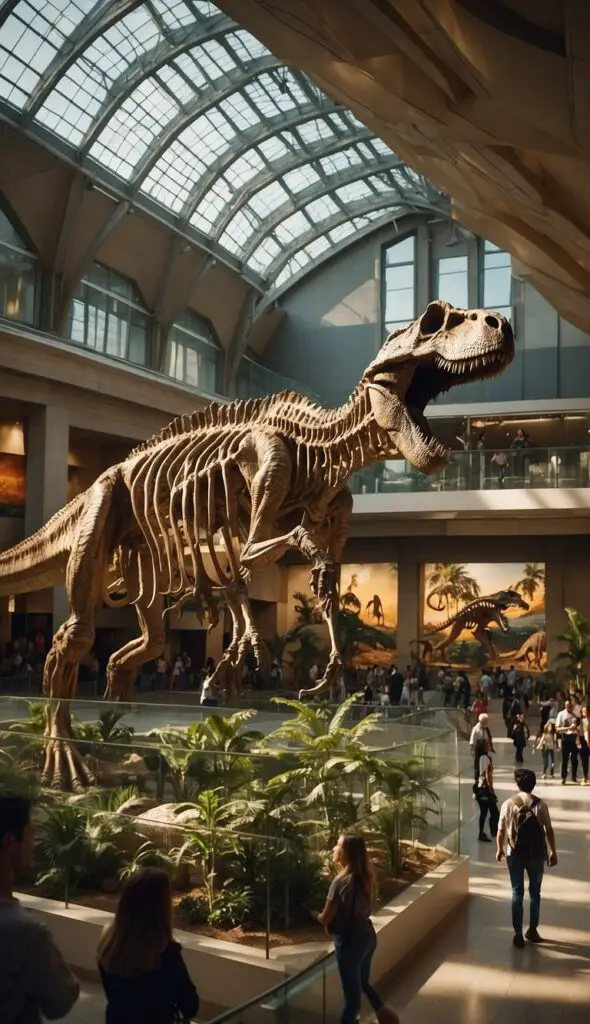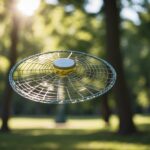Founded in 1812, the Academy of Natural Sciences of Drexel University in Philadelphia is the oldest natural science research institution and museum in the Americas. A visit to the Academy offers a fascinating journey through natural history, showcasing over 18 million specimens and archival works. Located across from Logan Square on the Ben Franklin Parkway, this institution has been dedicated to biodiversity and environmental science for over two centuries.

Current exhibits include “Crocs: Ancient Predators in a Modern World,” where visitors can come face-to-snout with live crocodilians. Another highlight is the ongoing focus on water, which renews appreciation for this vital element. The Academy is a hub for dynamic educational programs and events, hosting conferences such as the “Making Nature: The Labor of Natural History.”
The Academy of Natural Sciences also plays a significant role in research and academia. It’s a place where both scientists and curious minds come together, contributing to conservation efforts and the study of natural history. Whether you’re planning a visit or looking to support its mission, the Academy offers something for everyone.
Key Takeaways
- The Academy of Natural Sciences is the oldest natural science research institution in the Americas.
- Exhibits include live crocodilians and a focus on water conservation.
- The Academy is key in research, education, and conservation efforts.
History and Founding

The Academy of Natural Sciences of Philadelphia, now part of Drexel University, is the oldest natural science research institution and museum in the Americas. It has played a significant role in promoting scientific knowledge and research since its establishment in 1812.
Historical Milestones
The Academy of Natural Sciences was established on January 25, 1812, by a group of amateur scientists interested in natural history. It began in a private residence in Philadelphia and quickly grew in prominence. By 1876, it had moved to its current location near the Benjamin Franklin Parkway, a notable Philadelphia landmark.
Throughout its history, the Academy has made significant contributions to science and education. It houses over 18 million specimens, including many that predate the Academy itself. The institution has a longstanding commitment to biodiversity and environmental science, reflected in its extensive research and educational programs.
Influential Figures
Several influential figures have shaped the Academy’s legacy. William Maclure, a geologist and philanthropist, served as its first president. He was instrumental in defining the institution’s mission and direction.
Titian Peale, Thomas Say, and Charles Pickering were key early members who advanced the study of natural history through their fieldwork and collections. Later, renowned paleontologists Joseph Leidy and Edward Drinker Cope made significant contributions to the Academy’s research, particularly in paleontology and anthropology.
These individuals, along with many others, helped establish the Academy as a leading center of scientific research and education, maintaining its core mission of advancing useful learning. For more details, you can check out the Academy of Natural Sciences of Drexel University.
Exhibitions and Galleries

The Academy of Natural Sciences of Drexel University offers a wide range of exhibits that highlight biodiversity and natural history. From dinosaur fossils to detailed dioramas showcasing different ecosystems, visitors can explore various aspects of our natural world.
Dinosaur Hall
Dinosaur Hall is a major attraction that fascinates both young and old visitors. This exhibit features real fossils and life-sized models of dinosaurs. The collection includes the famous Tyrannosaurus rex and Triceratops. Informative displays provide insights into the lives and habitats of these ancient creatures. The exhibit aims to educate visitors on the importance of fossils and what they reveal about the Earth’s past. Interactive exhibits and educational programs add to the engaging experience.
North American Wildlife
The North American Wildlife gallery features realistic dioramas that depict various ecosystems across North America. From the arid deserts to lush forests, these displays highlight the region’s rich biodiversity. Key species such as bears, wolves, and deer are showcased in their natural habitats. The dioramas aim to provide a deeper understanding of the environment and the importance of conservation efforts. Live animal exhibits feature species native to North America, offering a closer look at these remarkable creatures.
African and Asian Ecosystems
This section is dedicated to the diverse ecosystems found in Africa and Asia. Detailed dioramas highlight the rich biodiversity of these continental regions. Visitors can explore the African savannah, home to lions, elephants, and giraffes, as well as Asian rainforests filled with tigers, monkeys, and exotic birds. These exhibits aim to educate on the different ecosystems and the unique species that inhabit them. Informational plaques and interactive displays offer more in-depth knowledge about these ecosystems and their significance.
Research and Academia
The Academy of Natural Sciences of Drexel University excels in scientific research and academic excellence through its outstanding contributions, robust collaborations, and extensive library and archival resources.
Scientific Contributions
The Academy has made significant contributions to various fields such as botany, ecology, and systematics. It houses over 18 million specimens, making it one of the largest natural history collections in the United States. These specimens support research in areas like molecular systematics and biodiversity. The Academy also publishes the Journal of the Academy of Natural Sciences and the Proceedings, which are essential resources for scientists and researchers worldwide.
Partnerships and Collaboration
The Academy’s partnership with Drexel University in 2011 marked a new era of academic collaboration. This affiliation has bridged gaps between university research and the Academy’s resources. The Center for Systematics & Evolution and the Patrick Center for Environmental Research are notable research centers within the Academy that collaborate on various projects. These partnerships enhance research in fields including geology and environmental science, providing students and researchers access to extensive expertise and resources.
Library and Archives
The Academy’s library and archives are invaluable assets for researchers. The library contains rare books, journals, and documents dating back to the 18th century. These resources include the writings of prominent naturalists and scientists, offering a rich historical perspective. The archives house extensive collections of specimen records, field notes, and unpublished manuscripts, invaluable for historical and contemporary research. Access to these materials supports ongoing research and enhances academic study across multiple disciplines.
Educational Programs and Events

The Academy of Natural Sciences of Drexel University offers a wide range of educational programs and events designed to inspire a deeper understanding of science and environmental sustainability. These activities include field trips, public lectures, and various outreach programs.
Field Trips and Group Visits
Field trips to the Academy of Natural Sciences provide students and groups with hands-on learning experiences. These visits allow participants to explore exhibits, interact with live animals, and engage in educational workshops. Schools and organizations can book guided tours where knowledgeable staff lead interactive discussions about biodiversity, earth sciences, and conservation.
Teachers can tailor their trips to specific grade levels and academic standards. The Academy offers resources and pre-visit lesson plans, ensuring that students are well prepared. Group visits don’t just aim to educate, but also to inspire curiosity and a lifelong interest in science and the natural world.
Public Programs and Lectures
The Academy hosts a variety of public programs and lectures aimed at all age groups. These events feature talks by scientists and experts on topics ranging from paleontology to climate change. Public lectures often coincide with special exhibitions or significant scientific discoveries, providing attendees with fresh insights and current information.
Additionally, the Academy organizes interactive workshops where participants can engage directly with scientific research and methodologies. These programs serve to demystify scientific processes and encourage community involvement in scientific endeavors. Public engagement is a key goal, fostering a community connected through shared learning and exploration.
Environmental and Scientific Outreach
The Academy’s outreach initiatives focus on promoting science education and environmental awareness beyond their physical location. Programs include Earth Day celebrations and sustainability workshops that are open to the local community. These initiatives often involve partnerships with schools, community organizations, and other educational institutions.
Mobile exhibits and pop-up events bring the Academy’s resources to diverse audiences, ensuring wider access to scientific education. Outreach activities also highlight pressing environmental issues and promote actions that individuals and communities can take to support sustainability. Through these efforts, the Academy of Natural Sciences actively contributes to building a more scientifically literate and environmentally conscious society.
Conservation Efforts

The Academy of Natural Sciences focuses on protecting species and restoring habitats. These activities are key to maintaining biodiversity and ensuring ecological health.
Species Protection
Species protection is crucial for biodiversity. The Academy is deeply involved in efforts to protect endangered species. They work with different organizations to monitor populations and implement conservation strategies.
For instance, they participate in breeding programs for at-risk animals. These programs help increase population numbers in captivity, and some animals are later reintroduced into the wild.
Field studies are another important aspect. Scientists track movements and behaviors to understand more about specific species. This data is used to make informed decisions about conservation efforts.
They also educate the public about the importance of protecting wildlife. Exhibits with live animals and interactive sessions engage visitors and raise awareness. By understanding the role each species plays in the ecosystem, the public can better appreciate the need for conservation.
Habitat Restoration
Habitat restoration is another key focus area. The Academy collaborates with local and global partners to restore damaged ecosystems.
One major project involves the restoration of watersheds. Healthy watersheds are essential for clean water and biodiversity. Often, this work includes removing invasive species and planting native vegetation.
They also work on restoring macroinvertebrate populations, which are small aquatic animals crucial for water quality and ecosystem health. Research shows that these organisms are key indicators of environmental changes.
In urban areas, habitat restoration includes creating green spaces and improving urban biodiversity. Projects like rooftop gardens and community-led planting drives are practical steps to restore nature in cities.
The results are tangible. Restored habitats support more species, help maintain ecological balance, and provide educational opportunities for the public. The Academy’s ongoing commitment to habitat restoration demonstrates its dedication to long-term environmental health.
Visitor Information

The Academy of Natural Sciences of Drexel University offers a detailed visitor experience with options for admission and memberships, accessible facilities, and clear directions. Here’s what you need to know when planning a visit.
Admission and Memberships
The Academy offers various ticket options. General admission includes access to all exhibits, and tickets can be purchased both online and at the door. Buying tickets online can save visitors $2 per ticket.
Memberships come with benefits like free admission, discounts on programs and parking, and special access to events. Different levels of membership cater to individuals, families, and even organizations.
Reduced rates are often available for seniors, students, and children. Free admission days may also be available on select dates.
Facilities and Accessibility
The Academy is designed to be accessible to all visitors. There are elevators and ramps that ensure all exhibits, including the Dinosaur Hall, are accessible. Restrooms are equipped with accessibility features, and wheelchairs are available upon request.
Dining options include a café where visitors can take a break and enjoy a meal. The gift shop offers a variety of educational products and souvenirs.
Families will find spaces like the “Outside In” exhibit, a hands-on nature area designed specifically for children. Baby changing facilities are also available.
Directions and Contact
The Academy is located at 1900 Benjamin Franklin Parkway in Philadelphia. It’s easily accessible by car, with several parking lots and garages nearby, some offering discounts for Academy visitors. Public transportation options include buses and the SEPTA train.
For detailed directions and parking information, visitors can check the official site.
For questions or more information, the Academy can be contacted at (215) 299-1000. Additionally, the website provides updated information on hours and upcoming events, making it a valuable resource for planning a visit.
Support and Membership

Supporting the Academy of Natural Sciences can be achieved through donations and memberships. Financial contributions help improve scientific research and community programs, while memberships offer a range of benefits for individuals and families.
Donor Opportunities
The Academy offers several ways to support its mission. Donations fund the care for a vast collection of scientific specimens. Sponsorship opportunities also exist, allowing businesses and individuals to support specific projects or exhibits. Contributions can be made online, making it easy to provide financial support. For more information, visit Support – The Academy of Natural Sciences of Drexel University.
Membership Benefits
Membership at the Academy provides numerous perks. Members enjoy discounts on parking, guest passes, and in the Academy Café and Shop. There is a special Kids Club membership for children 12 and under. Memberships can also include an extra adult for added flexibility. Members also receive exclusive access to family and adult programs. Learn more at Academy Membership – Academy of Natural Sciences of Drexel University.
Frequently Asked Questions

The Academy of Natural Sciences of Drexel University offers a range of opportunities, from employment to special events. There are ticket options available online, various engaging exhibits, and unique benefits for Drexel University students.
What are the employment opportunities at The Academy of Natural Sciences?
The Academy of Natural Sciences offers a variety of job opportunities in fields such as research, education, and museum operations. Interested individuals can view current job openings and apply through the Academy’s official employment page.
How can one purchase tickets to The Academy of Natural Sciences?
Tickets can be purchased online, where visitors can also save $2 per ticket. The Academy’s website provides information on hours and pricing. It is recommended to buy tickets in advance to ensure availability and to take advantage of any discounts.
What are some must-see exhibits at The Academy of Natural Sciences?
Visitors should not miss the Dinosaur Hall, which showcases impressive fossil specimens. The Butterfly Pavilion is another popular exhibit, offering an immersive experience with live butterflies. The dioramas featuring African and North American wildlife are also worth exploring.
Can you provide information about upcoming events at The Academy of Natural Sciences of Drexel University?
The Academy hosts a variety of events throughout the year, including educational programs, workshops, and special exhibitions. Visitors can check the Academy’s online calendar for the latest information on upcoming events and activities.
What benefits do Drexel University students have when visiting The Academy of Natural Sciences?
Drexel University students enjoy free admission to The Academy of Natural Sciences. They can also attend special events and lectures at no extra cost. This benefit is a great way for students to explore the museum and engage with its educational resources.
In which exhibit are dinosaur fossils displayed at The Academy of Natural Sciences in Philadelphia?
Dinosaur fossils are prominently displayed in the Dinosaur Hall. This exhibit features life-size skeletons and interactive displays that provide insights into the lives of these ancient creatures. The exhibit aims to educate and inspire visitors of all ages about paleontology.







